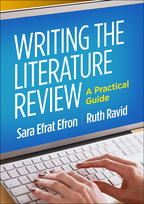Writing the Literature Review
A Practical Guide
Sara Efrat Efron and Ruth Ravid
HardcoverPaperbacke-bookprint + e-book
Hardcover
orderNovember 14, 2018
ISBN 9781462536900
Price: $66.00 298 Pages
Size: 7" x 10"
Paperback
orderNovember 23, 2018
ISBN 9781462536894
Price: $44.00298 Pages
Size: 7" x 10"
This accessible text provides a roadmap for producing a high-quality literature review—an integral part of a successful thesis, dissertation, term paper, or grant proposal. Each step of searching for, evaluating, analyzing, and synthesizing prior studies is clearly explained and accompanied by user-friendly suggestions, organizational tips, vignettes, and examples of student work. Also featured are excerpts from peer-reviewed quantitative, qualitative, and mixed methods articles. This is the first book to focus on crafting different types of reviews (systematic, traditional–narrative, or hermeneutic–phenomenological) that reflect the writer's research question, methodological choices, and approaches to knowledge. It describes what all reviews have in common and highlights distinct characteristics of each type. The book includes dos and don'ts for evaluating studies and constructing an argument, and software suggestions for locating, organizing, and arranging sources.
Pedagogical Features
Pedagogical Features
- Checklists and “To Do” activities that break down key steps to take.
- Boxed examples, graphics that organize and visually illustrate key concepts, and summary tables.
- Group activities that invite students to further explore and apply the methods discussed in each chapter.
- Detailed directions for using four different organizing strategies: synthesis matrix, summary table, mapping, and topic outline.
- End-of-chapter summaries and “What's Next” sections.
- Assessment matrices for reviewing and refining the completed literature review.



